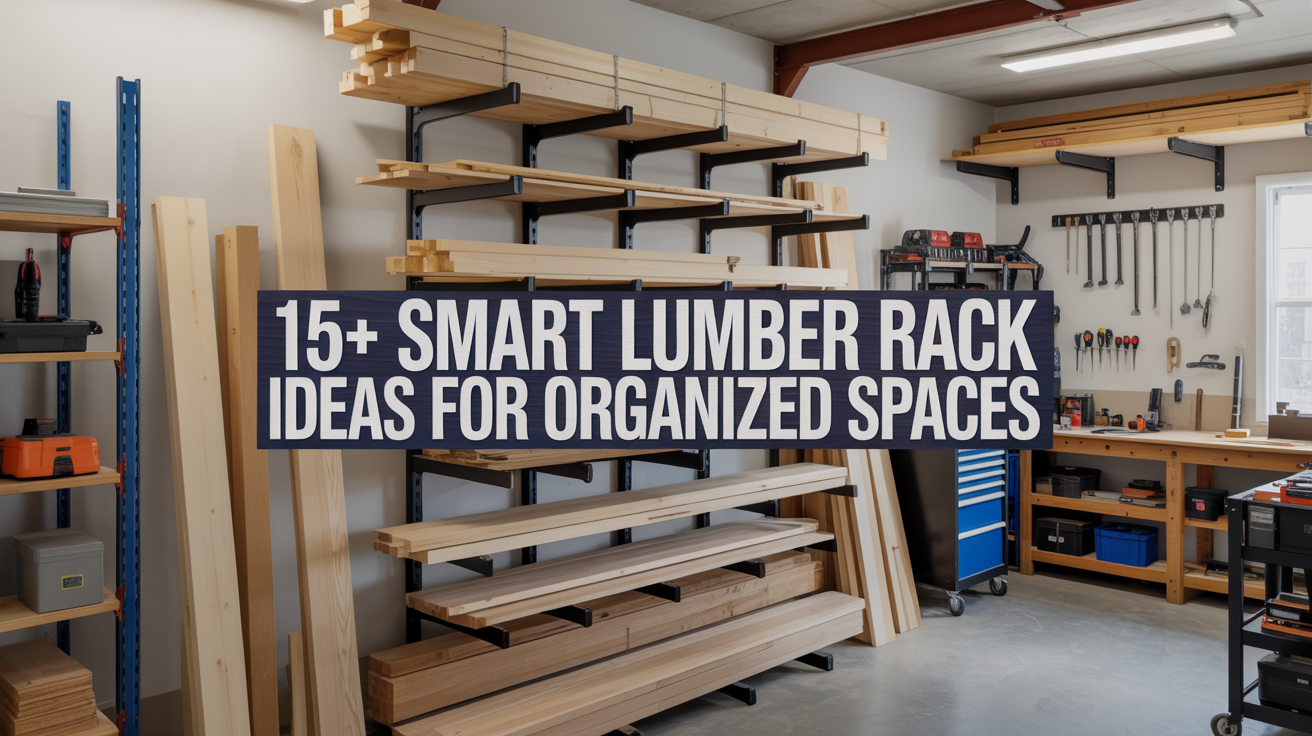15+ Smart Lumber Rack Ideas for Organized Spaces

If you’ve ever tripped over a 2×4 or lost a pricey hardwood board under a pile of offcuts, you know how frustrating lumber storage can be. A messy shop doesn’t just look bad—it slows you down and can even become dangerous. After 20+ years of building, organizing, and working in woodshops big and small, I’ve tested nearly every lumber storage method out there. What works? Smart lumber racks. They don’t just hold wood—they solve problems.
Here’s how to take your workspace from chaotic to clean with 15+ smart lumber rack ideas that are functional, flexible, and easy to build or buy.
1. Wall-Mounted Lumber Rack for Vertical Efficiency

Wall-mounted racks are the go-to option for saving floor space. When properly anchored into studs, they hold a surprising amount of weight. Storing lumber horizontally on wall brackets not only keeps boards visible and accessible, it also prevents warping from uneven pressure. Adjust the shelf spacing based on the type and thickness of wood you store most. This method is great for home garages where every square foot counts.
2. Ceiling-Hung Lumber Storage for Overhead Space

If your walls are full, look up. Overhead lumber racks use the ceiling area—often wasted space. Suspended frames or steel tracks can carry long boards securely, provided they’re properly supported and you avoid overloading them. This style is especially handy in small workshops or single-car garages where floor and wall real estate is already tight. Just make sure to allow enough clearance for garage doors or overhead lights.
3. Rolling Lumber Cart for Flexibility

For those who need to move their wood stash around, a rolling lumber cart is gold. These mobile units can store cutoffs, sheet goods, and long boards, all in one place. Some designs include vertical slots for organizing shorter scraps and horizontal shelves for full-length lumber. Lockable caster wheels ensure it stays put when needed. It’s a perfect solution for shared or multi-use workspaces.
4. Vertical Lumber Rack for Compact Footprints

A vertical lumber rack uses height instead of width. It stores boards upright, saving tons of room. It’s ideal for narrow areas or when you want to keep your most-used pieces within arm’s reach. Use spacers or dividers to separate types of wood, which keeps the pile from becoming a tangled mess. Place heavier stock at the back to stabilize the whole unit.
5. Adjustable Cantilever Racks for Heavy-Duty Storage

Cantilever racks shine when you’ve got long, heavy boards and need industrial-level support. These steel systems are common in warehouses but are surprisingly practical for serious home woodworkers too. Arms can be adjusted up or down to match your needs. For added safety, bolt the rack to the wall or floor. They’re not cheap, but they’ll last a lifetime and then some.
6. Fold-Down Wall Racks for Space-Saving Magic

In tiny shops, fold-down racks are a game-changer. When not in use, they tuck flat against the wall. When you need them, they open out to support lumber, pipes, or tools. This kind of rack is especially helpful in garages that double as car storage, allowing you to reclaim your space in seconds. Build it from strong plywood and heavy-duty hinges.
7. French Cleat Lumber Storage for Modular Use

The French cleat system offers unmatched flexibility. Attach a cleat to the wall and mount individual lumber holders that can be rearranged anytime. This method grows with your needs. As your wood collection changes, so can your setup. It also works well for storing jigs, clamps, and tools right alongside your lumber.
8. Corner Rack Systems to Maximize Awkward Spaces

Corners are often wasted, awkward, and ignored. But with a little planning, they can become storage goldmines. A corner lumber rack can be triangular or L-shaped and is perfect for stashing long offcuts or low-use boards out of the way. The key is building it strong enough to handle the weight while still letting you grab what you need without a struggle.
9. Sheet Goods Rack with Tilted Support

Sheet goods like plywood and MDF are awkward to store flat and dangerous to lean upright against walls. A tilted rack solves this. Built at a gentle angle, it holds full sheets securely without warping and makes it easy to slide out one at a time. Reinforce the bottom to handle the weight and add handles or wheels for better mobility.
10. Multi-Purpose Racks for Boards and Tools

Sometimes you don’t need a ton of storage—just something smart. A compact multi-use rack can hold a small amount of lumber plus clamps, rulers, and hand tools. Hang it on the wall near your main bench for quick access. The best designs use pegboard backing, open trays, or magnetic strips to make use of every inch.
11. DIY Plywood Crate Racks for Affordability

When budget is tight, build your rack from plywood crates. These box-style units can be stacked, bolted, or arranged like cubbies. Store scraps in the smaller ones and full boards in the longer ones. Paint or seal them to prevent warping in humid shops. The key here is flexibility—move, rebuild, or resize as your needs evolve.
12. Under-Bench Storage for Hidden Capacity

The space beneath your workbench is often underused. Adding a low-profile lumber rack under your bench turns dead space into valuable storage. Store offcuts, trim pieces, or even small sheet goods. Keep the opening wide enough to reach in without scraping your knuckles, and use labels to avoid digging through every piece just to find one.
13. Wall Grid Systems with Hooks and Brackets

Wall grids are like the Swiss Army knives of storage. Add hooks, trays, or angled brackets to hold lumber of all lengths. The metal grid allows you to move and customize as your woodpile changes. This is great for folks who don’t want to commit to drilling into studs or who want to keep things ultra-adaptable.
14. Pallet Racks Repurposed for Lumber

Got access to industrial pallet racking? It’s one of the toughest, roomiest systems around. Designed to hold tons (literally), it makes an excellent lumber rack when modified. Add plywood shelves, cut down the height, or reinforce certain sections for extra-long stock. This is ideal for semi-professionals or anyone with bulk lumber needs.
15. Fence Rail Racks for Outdoor Wood Storage

If you store lumber outside, build a rack using galvanized fence rails. These steel pipes resist rust and hold up in all weather. Concrete the posts in for a solid foundation and create horizontal rails to support wood. Keep boards off the ground and cover the top with a tarp or corrugated roof to protect from sun and rain.
16. Overhead Garage Door Track Storage

Here’s a sneaky trick most people miss: the space above your garage door. This narrow strip is often untouched but works great for thin stock or trim pieces. Use lightweight shelving or brackets mounted parallel to the track. Just make sure it doesn’t interfere with the door’s operation. It’s a clever way to add storage without sacrificing floor or wall space.



